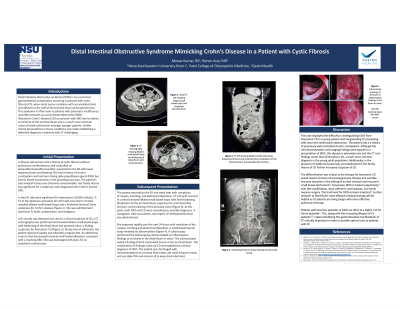Sunday Poster Session
Category: Small Intestine
P1590 - Distal Intestinal Obstructive Syndrome Mimicking Crohn’s Disease in a Patient With Cystic Fibrosis
Sunday, October 27, 2024
3:30 PM - 7:00 PM ET
Location: Exhibit Hall E

Has Audio

Manav Kumar, BS
Nova Southeastern University
Davie, FL
Presenting Author(s)
Manav Kumar, BS1, Ronen Arai, MD2
1Nova Southeastern University, Davie, FL; 2Gastro Health, Coral Springs, FL
Introduction: Distal intestinal obstructive syndrome (DIOS) occurs as a complication of cystic fibrosis (CF) when viscid mucus combines with accumulated stool in the small bowel and can present as small bowel obstruction (SBO). Ileocecal Crohn’s disease (CD) also commonly presents with SBO. Similar presentations in these conditions may make establishing a definitive diagnosis in a CF patient challenging.
Case Description/Methods: A 30 y/o woman with CF, controlled on elexacaftor/tezacaftor/ivacaftor without pulmonary manifestations, presented to the ER with lower abdominal pain and bloating. She suffered from chronic constipation and had been taking daily polyethylene glycol (PEG) but had no bowel movements in the preceding 2 days. Her maternal uncle was diagnosed with CD. ER labs showed leukocytosis (19k). CT A/P showed dilated small bowel loops and a thickened terminal ileum. She was admitted and started on IV fluids, ondansetron, and analgesics. Due to a suspicion of CD, a CT enterography was performed and showed dilated small bowel loops with thickening of the distal ileum and proximal colon, suspicious for ileo-colonic CD. She improved rapidly, tolerated a regular diet, and was discharged with plans for an outpatient colonoscopy. She returned a week later with nausea, vomiting, and abdominal distention. CT showed dilated small bowel loops with ileal thickening, a possible terminal ileal stricture, and proximal colon thickening. At this point, both DIOS and CD were considered. A nasogastric tube was placed, and empiric IV steroids were administered. She improved rapidly over the next 24 hours. A small bowel series revealed no abnormalities, and a colonoscopy performed the following day revealed no strictures or inflammatory findings in the ileum or colon, thus ruling out CD and establishing a diagnosis of DIOS. The patient was discharged with recommendations to increase fluid intake, eat small frequent meals, and use daily PEG and mineral oil to keep stool lubricated.
Discussion: This case displayed the difficulty in distinguishing DIOS secondary to long-standing CF from CD. The appearance of DIOS on CT mimicked that of ileal CD. A family history of CD increased suspicion of CD, in the presence of chronically stable, uncomplicated CF. The differentiation was critical as the therapy for ileocecal CD would require immunosuppressive therapy and possible bowel resection. Conversely, DIOS is generally treated conservatively with diet modification, stool softeners, and laxatives, and rarely requires surgery.
Disclosures:
Manav Kumar, BS1, Ronen Arai, MD2. P1590 - Distal Intestinal Obstructive Syndrome Mimicking Crohn’s Disease in a Patient With Cystic Fibrosis, ACG 2024 Annual Scientific Meeting Abstracts. Philadelphia, PA: American College of Gastroenterology.
1Nova Southeastern University, Davie, FL; 2Gastro Health, Coral Springs, FL
Introduction: Distal intestinal obstructive syndrome (DIOS) occurs as a complication of cystic fibrosis (CF) when viscid mucus combines with accumulated stool in the small bowel and can present as small bowel obstruction (SBO). Ileocecal Crohn’s disease (CD) also commonly presents with SBO. Similar presentations in these conditions may make establishing a definitive diagnosis in a CF patient challenging.
Case Description/Methods: A 30 y/o woman with CF, controlled on elexacaftor/tezacaftor/ivacaftor without pulmonary manifestations, presented to the ER with lower abdominal pain and bloating. She suffered from chronic constipation and had been taking daily polyethylene glycol (PEG) but had no bowel movements in the preceding 2 days. Her maternal uncle was diagnosed with CD. ER labs showed leukocytosis (19k). CT A/P showed dilated small bowel loops and a thickened terminal ileum. She was admitted and started on IV fluids, ondansetron, and analgesics. Due to a suspicion of CD, a CT enterography was performed and showed dilated small bowel loops with thickening of the distal ileum and proximal colon, suspicious for ileo-colonic CD. She improved rapidly, tolerated a regular diet, and was discharged with plans for an outpatient colonoscopy. She returned a week later with nausea, vomiting, and abdominal distention. CT showed dilated small bowel loops with ileal thickening, a possible terminal ileal stricture, and proximal colon thickening. At this point, both DIOS and CD were considered. A nasogastric tube was placed, and empiric IV steroids were administered. She improved rapidly over the next 24 hours. A small bowel series revealed no abnormalities, and a colonoscopy performed the following day revealed no strictures or inflammatory findings in the ileum or colon, thus ruling out CD and establishing a diagnosis of DIOS. The patient was discharged with recommendations to increase fluid intake, eat small frequent meals, and use daily PEG and mineral oil to keep stool lubricated.
Discussion: This case displayed the difficulty in distinguishing DIOS secondary to long-standing CF from CD. The appearance of DIOS on CT mimicked that of ileal CD. A family history of CD increased suspicion of CD, in the presence of chronically stable, uncomplicated CF. The differentiation was critical as the therapy for ileocecal CD would require immunosuppressive therapy and possible bowel resection. Conversely, DIOS is generally treated conservatively with diet modification, stool softeners, and laxatives, and rarely requires surgery.
Disclosures:
Manav Kumar indicated no relevant financial relationships.
Ronen Arai: Abbvie – Speakers Bureau. BMS – Speakers Bureau. Castle Biosciences – Speakers Bureau. Celltrion – Speakers Bureau. Janssen – Speakers Bureau. Lilly – Speakers Bureau. Pfizer – Speakers Bureau. Phathom Pharmaceuticals – Speakers Bureau. Prometheus Pharmaceuticals – Consultant. Takeda – Speakers Bureau.
Manav Kumar, BS1, Ronen Arai, MD2. P1590 - Distal Intestinal Obstructive Syndrome Mimicking Crohn’s Disease in a Patient With Cystic Fibrosis, ACG 2024 Annual Scientific Meeting Abstracts. Philadelphia, PA: American College of Gastroenterology.
